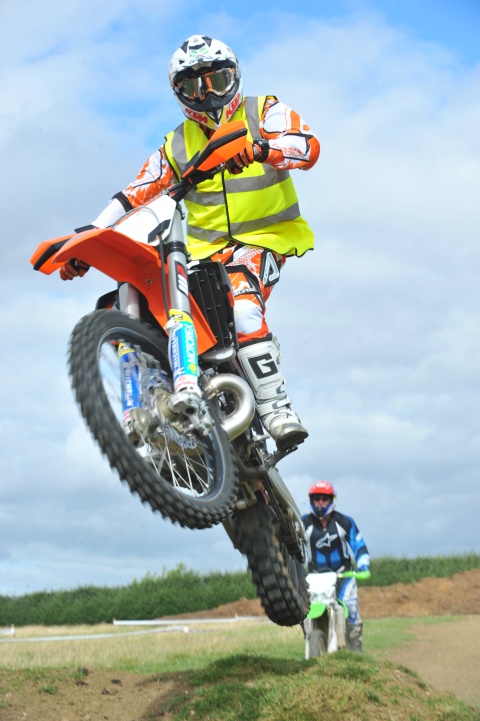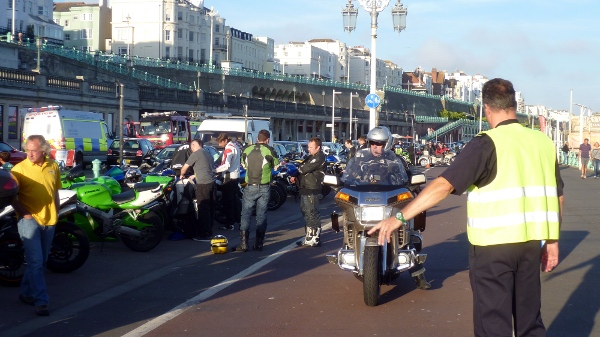To Be Seen Or Not Seen...that is the question
Les Vis-erables
John Newman
There's been an outbreak of yellow, and I don't mean Daffodils. It's the inexorable rise of hi-vis clothing that is sweeping the land. Everyone is wearing it, from crocodiles of small children being shepherded to and from school to utility workers in trenches, where any actual hi-vis is lost under smears of dirt and mud. Truck and bus drivers wear them while at the wheel; probably because they can't be bothered to pull them on and off.
They are the most unflattering of garments, and yet a good number of motorcycle riders seem to have taken to them with enthusiasm, and riding gear manufacturers present the consumer with a range of jackets incorporating the dazzling yellow; and waist coat type vests worn over conventional non-reflective clothing are the alternative.
Is this just a 'silly phase we're going through' to paraphrase the 10CC song? Is there any evidence that the wearing of the yellow prevents accident or injury? Do insurance companies stipulate the donning of hi-vis in certain situations? Are we on the road to eventual compulsion?
They call it Mellow Yellow
A small incident illustrating how much hi-vis has penetrated behaviour and thinking occurred a couple of years ago when I was photographing CBT rider training in a large car park marked out with cones to guide the riders. Just as I had begun snapping away, with the okay of the training school and the riders; I was asked to don a hi-vis jacket. I asked why. It was a bright day; visibility was boundless; the riders were doing nought miles per hour; and I wasn't about to leap in front of the small capacity bikes. Insurance was the stated reason.
We have no idea of course as to the effectiveness or otherwise of hi-vis. And just like with road cones, I wish I'd been one of the people who had anticipated its ubiquity. Riches and a big shed full of bikes would have been sure to follow.
In November of last year two academics who were also cyclists initiated a study to try and determine whether the type of clothing worn by cyclists makes a difference as to whether motorists who pass dangerously close have actually seen them. The study has suggested that whether high visibility clothing is worn or not, the behaviour of a small percentage of drivers will not be affected. Although this study was primarily about cyclists safety it can have a relevance to motorcycles, especially on small capacity machines and riding in congested urban environments.
One of the research team, Dr Ian Garrard from Brunel University, used a distance sensor on his daily commute to determine how close each vehicle passed. He also used a range of different clothing including lycra cycle racing gear to denote an experienced rider; a hi-vis vest with 'novice cyclist' printed on the back; and a vest that indicated the cyclist was making a video recording.
With his colleague Dr Ian Walker from Bath University the data they collected from 5,690 passing vehicles was analysed, and the sensor measures found that whatever clothing was worn that 1-2% of motorists passed within 50cms. Check that distance on a tape or ruler; it is not much. And although the percentage of dangerously close passers is very small, it only takes one to take you out.

Note ConeHead the barbarian
Note: The Transport Research Laboratory carried out a similar study in 1979 and the average passing distance given to cyclists was 179cms; but in this study the average distance had reduced to 118cms. Perhaps indicating increased traffic density but decreasing consideration.
They concluded that in overtake situations it doesn't matter how visible you try to be on a cycle: for some, cocooned in their metal shells, and no doubt either lacking concentration or distracted by myriad gadgets and other (selfish) concerns. Their driving behaviour will present a danger.
They noted in their paper that there is little evidence that the wearing of high visibility clothing worn either by cyclists or motorcyclists offers any safety benefits in daytime, or is an 'easy fix' to our vulnerability. In this exercise they did not test whether at junctions, cross roads etc the displaying of hi-vis makes a difference, and for us motorcyclists these situations are a common cause of our demise along with cars turning into us when they fail to look in mirrors, or decide to carry out a manoeuvre at the last minute.
Yeah, they were all yellow
At various times down the years people have put forward ideas for trying to make car, truck, bus drivers etc more aware of the vulnerability of two wheelers. Including making it a condition of gaining a licence that some experience of riding a motorcycle or scooter is precursor to this. It is of course never ever going to happen.
The car theory test poses a number of questions related to the safety of motorcyclists and cyclists, but this is a rote learning exercise through on line CD's or publications, and will do little to embed knowledge for drivers. As with other aspects of the increasingly frenetic pace of our lifestyles, driving has become part of the necessary oxygen of existence: and the safety awareness of drivers is bound up in a complex web of circumstances, psychology and behaviour.
Police road traffic crash experience tells us time and again that the majority of incidents are caused through inattention and lack of concentration, and therefore we can only protect ourselves through road acquired know how, anticipation, and adopting assertive riding habits.
If, as a rider, you feel that reflective clothing of whatever description helps to make your ride safer, that's fine. As with other 'safety' measures that are intended to make riders survive and enjoy their bike journeys, we should never substitute it for the acquisition of skill and experience. The only way to gain this is to get out there and ride. Enjoy the coming months with warmer temperatures and dryer roads; and be careful out there as they say.
Any reflections on this subject either for or against? If so email us at:
[email protected]
John Newman
for Wemoto News




